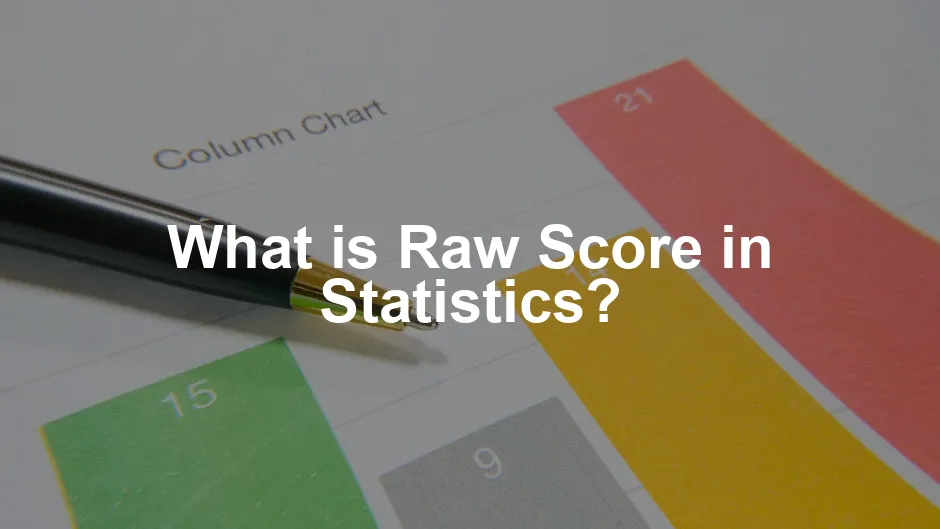Introduction
A raw score is a simple term in statistics. It represents the original, unaltered score from tests or observations. Think of it as the score you receive on a quiz before any adjustments or transformations. For instance, if you answer 18 questions correctly on a 20-question test, your raw score is 18.
Raw scores play a vital role in statistical analysis. They serve as the foundation before any calculations or modifications. When you hear the term “raw score,” think about it as the untouched data point that researchers work with. It provides a clear snapshot of performance without any frills or alterations.
Understanding raw scores is crucial across various fields. In education, they help educators gauge student performance. In psychology, raw scores are used for assessments and evaluations. Data analysts also rely on raw scores to interpret trends and patterns. Without raw scores, comparisons and insights would be challenging to achieve.
In a nutshell, grasping raw scores is essential. They are the starting point for deeper analysis. Knowing how to interpret them can empower you to draw meaningful conclusions from data. So, let’s dive deeper into what a raw score truly is!

Understanding Raw Score
Definition of Raw Score
A raw score is an unaltered data point derived from tests or observations. It’s the score you get at face value. For example, if you take an exam with 30 questions and answer 25 correctly, your raw score is 25. It’s straightforward, right?
Let’s consider a different example. In a standardized test, if a student answers 15 out of 20 questions correctly, their raw score is 15. This score reflects their actual performance without any transformations. Raw scores can also vary based on the test format or scoring methodology.
In some cases, raw scores can be represented as whole numbers, while in other instances, they may involve points awarded by a grader. The key takeaway is that raw scores represent the simplest form of measurement and provide the basis for further analysis.
Raw scores are essential for initial comparisons. They help rank individuals and assess performance. However, raw scores alone may not give a complete picture. The context surrounding the raw scores matters significantly. For instance, a raw score of 25 out of 30 indicates strong performance, while a raw score of 25 out of 100 suggests the opposite. Context is king when it comes to interpretation!
Understanding raw scores is the first step in the statistical journey. They lead us to transformed scores, like z-scores, which offer more insights. But remember, raw scores are the original data points that hold their value and significance in assessments. They are the starting line in the race of statistical analysis!

Characteristics of Raw Scores
Raw scores have distinct properties that make them straightforward yet impactful. First, they are whole numbers. No fractions or decimals here! This simplicity allows for clear interpretation of results. A raw score represents actual performance, reflecting the number of correct answers or points earned in tests or assessments. For example, if you answered 18 out of 20 questions correctly, your raw score is 18.
What sets raw scores apart from transformed scores, like z-scores or T-scores? Transformed scores involve some mathematical wizardry. They adjust raw scores based on mean and standard deviation, creating a new scale. In contrast, raw scores remain untouched, serving as the original data points. Think of raw scores as the unfiltered truth, while transformed scores add a layer of complexity to the analysis.
To keep your studies organized and efficient, consider using an Academic Planner. This handy tool can help you keep track of assignments, exams, and important deadlines, ensuring you never miss a beat in your academic journey!

Importance of Raw Scores
Why are raw scores significant? They form the bedrock of statistical analysis. Raw scores provide an initial snapshot of performance that helps in making comparisons and rankings. For instance, a teacher might use raw scores to determine which students excelled in a test. But hold your horses! Raw scores have their limitations. Without context, they might mislead interpretations.
Let’s say you scored 25 out of 30 on one test and 25 out of 100 on another. The raw score of 25 may look identical, but the context tells a different story! This illustrates that while raw scores are fundamental, they require additional information for meaningful insights. So, always keep context in mind when interpreting raw scores—they’re just the starting point in the grand statistical adventure!

Calculation of Raw Score
Formula for Raw Score Calculation
Ready to crunch some numbers? The formula for calculating raw scores from z-scores, mean, and standard deviation is as follows:
Raw Score = μ + zσ
Let’s break this down. Each component plays a crucial role.
- Mean (μ): This is the average of all scores in your dataset. It’s like the central hub, giving you a point of reference.
- Z-score (z): This tells you how far a particular score is from the mean, measured in standard deviations. A positive z-score indicates the score is above average, while a negative one indicates it’s below average.
- Standard Deviation (σ): This measures the spread of scores in your dataset. A low standard deviation means scores are closely clustered around the mean, while a high standard deviation indicates a wider spread.
Using this formula, you can convert z-scores back to raw scores, allowing for comparisons across different datasets. It’s a handy tool in your statistical toolkit!

Example Calculation
Let’s break down how to calculate a raw score with a practical example. Imagine a high school student, Alex, taking a math test. The test consists of 20 questions, and Alex answers 15 correctly.
First, we need to identify the components required for our formula:
- Mean (μ): Let’s say the average score of all students on this test is 75.
- Standard Deviation (σ): The standard deviation for this test is 10.
- Z-score (z): To determine how Alex’s performance compares to the average, we calculate the z-score. If we assume Alex’s raw score is below the mean, let’s say it’s -0.5.
Now, we can apply the formula for converting z-scores back to raw scores:
Raw Score = μ + zσ
Substituting in the values:
Raw Score = 75 + (-0.5 × 10)
Calculating that gives us:
Raw Score = 75 – 5 = 70
So, Alex’s raw score is 70. This score reflects his performance in the context of all test-takers. It’s a straightforward example that illustrates how one can derive a raw score from a z-score.

Tools for Calculating Raw Scores
Calculating raw scores doesn’t have to be a headache. There are plenty of tools available to help simplify this process. Here are a few options:
- Online Calculators: Websites like Omni Calculator and Statisticshowto offer dedicated raw score calculators. You simply input your z-score, mean, and standard deviation, and voilà! The raw score appears like magic.
- Spreadsheet Software: Microsoft Excel or Google Sheets can be used to create your own raw score calculator. With simple formulas, you can plug in your z-score, mean, and standard deviation to get instant results.
- Mobile Apps: There are numerous mobile applications designed for statistics students. Look for apps that feature statistical calculators—many support raw score calculations.
To use these tools effectively, follow these steps:
- Input the z-score: This represents how far your score is from the mean.
- Enter the mean: The average score of your dataset.
- Insert the standard deviation: This tells how much variation exists from the average.
Once you’ve entered this data, hit calculate, and your raw score will be displayed, saving you time and effort. With these tools, you can confidently tackle raw score calculations without breaking a sweat!

Comparison of Raw Scores and Transformed Scores
When it comes to analyzing data, both raw scores and transformed scores have their perks. Raw scores are the straightforward, unaltered results from tests or observations. They’re like that friend who tells it like it is—no sugarcoating. For instance, if a student answers 18 out of 20 questions correctly, their raw score is 18. Simple, right?
On the flip side, transformed scores, such as z-scores, take raw scores to another level. They adjust the scores based on the mean and standard deviation, providing a context that raw scores lack. This transformation is helpful when comparing scores across different tests or populations.
Advantages of raw scores include their simplicity and ease of interpretation. They reflect actual performance directly, making it easy to see how well someone did. However, they can be misleading without context. A raw score of 25 could mean a stellar performance on a 30-question test or a dismal one on a 100-question exam.
Transformed scores, while a bit more complicated, offer a deeper understanding of performance. They allow for comparisons across different scales and provide insight into how a score relates to the average. But they come with a downside: they require calculations and can be less intuitive for those not familiar with statistical concepts.
In summary, raw scores are best used when you want a clear, direct measure of performance. But when you need to compare results across different tests or interpret performance relative to a group, transformed scores are your best bet.

Limitations of Raw Scores
Raw scores, while useful, have their limitations. They often fail to provide meaningful comparisons across different tests or populations. Imagine comparing the raw scores from a math test and a science test. A student might score 80 on both, but what does that really mean? Without context, these scores are like apples and oranges—both fruits, but entirely different.
One major drawback of raw scores is their inability to indicate how a score stands relative to others. A raw score of 70 might seem impressive. However, if the average score is 90, that 70 starts to look a bit sad. Context is vital when interpreting raw scores. They can mislead if taken at face value without understanding the scoring criteria or the population being assessed.
Consider standardized tests, where raw scores are the initial data points. These scores need transformation for meaningful comparisons across different groups. Without converting to percentiles or z-scores, raw scores alone don’t tell the whole story. They don’t account for variations in test difficulty or participant demographics, making them less reliable for broad interpretations.
In conclusion, raw scores serve as a useful starting point, but context is crucial. Always consider the bigger picture when interpreting raw scores to avoid drawing misleading conclusions.

Applications of Raw Scores
In Education
Raw scores are a staple in education, particularly in academic assessments and standardized testing. Educators rely on these unaltered scores to evaluate student performance and growth. When a student takes a math test and scores 85 out of 100, that raw score provides immediate feedback on their understanding of the material. It’s a straightforward way to gauge how well they grasp concepts.
In standardized testing, raw scores help schools determine student placement or eligibility for advanced programs. For example, if a student performs exceptionally well on a standardized test, their raw score can qualify them for gifted and talented programs. It’s a direct reflection of their abilities without any transformations clouding the picture.
However, raw scores alone don’t tell the entire story of a student’s academic journey. Educators use them alongside other metrics to measure growth over time. For instance, comparing raw scores from a student’s first test to their latest can show improvement, highlighting the effectiveness of teaching strategies or interventions.
In summary, raw scores play a crucial role in education. They provide clear, straightforward measures of student performance and growth, enabling educators to make informed decisions. However, they should be interpreted within a broader context to ensure a complete understanding of student progress.

In Psychology and Behavioral Studies
Raw scores are crucial in psychology, especially in testing and assessments. They provide the foundation for measuring an individual’s performance. When psychologists conduct tests, raw scores reflect a participant’s responses directly. For instance, if a patient answers 20 out of 25 questions correctly on a mood assessment, their raw score is 20. This score is vital for understanding their emotional state.
In diagnosing behavioral patterns, raw scores shine brightly. They help practitioners establish baselines for individuals. A raw score can indicate where someone stands compared to normative data. This comparison can unveil significant insights into mental health conditions. For example, if a raw score falls well below the average, it may signal the presence of anxiety or depression. Thus, understanding raw scores is essential for developing tailored treatments.

In Business and Data Analysis
Businesses heavily rely on raw scores to gauge customer feedback and product reviews. When customers fill out surveys, their raw scores—like ratings from 1 to 5—offer immediate insight into satisfaction levels. A product with a raw score of 4.5 suggests a favorable reception, while a score of 2 raises red flags. These scores help companies identify strengths and weaknesses in products or services.
Moreover, raw scores play a pivotal role in data-driven decision-making. Companies analyze these scores to understand trends and customer preferences. By examining raw scores over time, businesses can spot patterns, allowing them to make informed adjustments. For instance, if a particular feature consistently receives low raw scores, it may need improvement. Therefore, raw scores are indispensable for enhancing customer experiences and optimizing performance metrics.

FAQs
Please let us know what you think about our content by leaving a comment down below!
Thank you for reading till here 🙂
Understanding raw scores is essential in various fields, including education and psychology. For more insights, check out this education statistics digest.
Raw scores in psychology provide a foundation for assessments. For a deeper understanding of research methods, refer to the research methods and statistics in psychology 2nd edition bains.
Understanding the concept of mean is crucial when analyzing raw scores. To learn more, visit what does mean identically distributed in statistics.
And for those late-night study sessions, consider investing in a pair of Noise-Canceling Headphones. These beauties will help you tune out distractions and focus on those raw scores like a pro!
Don’t forget to keep your workspace tidy with a Desk Organizer. A clean desk leads to a clear mind, and who doesn’t want that while calculating those pesky raw scores?
Lastly, if you’re looking to unwind after all that number crunching, why not grab a Scented Candle? A little relaxation goes a long way in maintaining your sanity while navigating the world of statistics!
All images from Pexels




